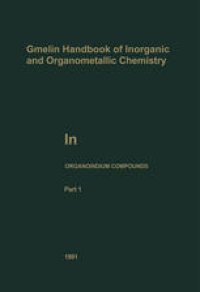
Ebook: In Organoindium Compounds
- Tags: Gmelin
- Series: Gmelin Handbook of Inorganic and Organometallic Chemistry / Gmelin Handbuch der Anorganischen Chemie I-n / 1- / 1 : In. Indium (System-Nr. 37)
- Year: 1991
- Publisher: Springer-Verlag Berlin Heidelberg
- Edition: 8
- Language: English
- pdf
The present volume contains all compounds in which at least one indium-carbon bonding interaction can be assumed. The compilation starts with the simplest compound of trivalent indium, In(CHh, and ends with studies about the interaction of indium with carbon monoxide 3 in an argon matrix. Literature coverage is intended to be complete to spring 1991 with various examples up to September 1991. The arrangement is closely related to that of the organogallium volume and documents the similarities between the two elements. Following the indium triorganyls and their adducts with Lewis bases in Section 1, the broad field of compounds of the general type R ln- n 3 n (n = 1, 2) is treated in sections 2 to 9; X represents a ligand bonded with a non-carbon atom to the indium atom. The arrangement of the various ligands follows the order group 17, 16, 15, etc. elements, with few compounds having direct indium-transition metal bonds. Ionic species, predominantly [R lnX -n]-compounds (n = 1 to 4), close the series of trivalent n 4 organoindium compounds and are collected in Section 11. Compounds of formally low valent indium (In", Ini, and Ino), with one R 1nlnR species having an In-In bond, form Section 12; 2 2 an extended chapter therein is dedicated to the young area of Cp*ln compounds in which i formalln is coordinated in an T] 5 manner.
This volume is a comprehensive collection of organoindium compounds which have been of increasing interest in the last few years. It covers all of the chemical, physical, and structural information of compounds containing an indium-to-carbon bond. It begins with In(CH3)3, the most studied organoindium compound, it being not only the starting material for many other organo-indium compounds but also being an important chemical agent in producing semiconducting layers by gas phase epitaxy (MOVPE), and ends with studies on the interacton of indium with carbon monoxide in an argon matrix. Among the many topics covered are the bonds of organoindium fragments to group 15 to 17 elements. Compounds of these types have increasingly been tested as source materials for MOVPE experiments. A special chapter is dedicated to indium in lower oxidation states, especially C5H5In, and their substituted derivatives in which formal In(I) is bonded to the ligand in an n5-manner. The structural versatility in organoindium compounds has stimulated much recent interest. Various types of bridging systems involving four- to eight-membered indium-containing heterocycles or polymers are well documented.